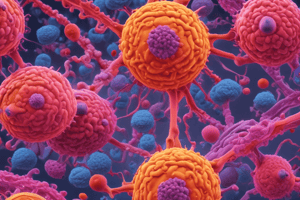Podcast
Questions and Answers
What is the leading cause of cancer-related deaths worldwide?
What is the leading cause of cancer-related deaths worldwide?
- Skin cancer
- Leukemia
- Breast cancer
- Lung cancer (correct)
What is the most deadly type of skin cancer?
What is the most deadly type of skin cancer?
- Squamous Cell Carcinoma
- None of the above
- Basal Cell Carcinoma
- Malignant Melanoma (correct)
What is the most deadly type of skin cancer?
What is the most deadly type of skin cancer?
- Squamous Cell Carcinoma
- Non-melanoma Skin Cancer
- Malignant Melanoma (correct)
- Basal Cell Carcinoma
Which type of skin cancer is the most deadly?
Which type of skin cancer is the most deadly?
What is the 5-year survival rate for lung cancer?
What is the 5-year survival rate for lung cancer?
What is the 5-year survival rate for lung cancer?
What is the 5-year survival rate for lung cancer?
Which type of breast cancer is the most common?
Which type of breast cancer is the most common?
What is the most common type of breast cancer?
What is the most common type of breast cancer?
What is the most common type of breast cancer?
What is the most common type of breast cancer?
What is the most common site of metastasis for breast cancer?
What is the most common site of metastasis for breast cancer?
What is the most common site of metastasis for breast cancer?
What is the most common site of metastasis for breast cancer?
What is the most common site of metastasis for breast cancer?
What is the most common site of metastasis for breast cancer?
What is the main cause of lung cancer?
What is the main cause of lung cancer?
What is the most common type of lung cancer?
What is the most common type of lung cancer?
What is the 5-year survival rate for patients diagnosed with skin cancer?
What is the 5-year survival rate for patients diagnosed with skin cancer?
What is the most common risk factor for lung cancer?
What is the most common risk factor for lung cancer?
What is the most common surgical intervention for breast cancer?
What is the most common surgical intervention for breast cancer?
What is the main risk factor for lung cancer?
What is the main risk factor for lung cancer?
What is the survival rate for 1 mm thick skin cancer lesions?
What is the survival rate for 1 mm thick skin cancer lesions?
What are the risk factors for skin cancer?
What are the risk factors for skin cancer?
Which type of lung cancer is more common?
Which type of lung cancer is more common?
What is the most common surgical intervention for breast cancer?
What is the most common surgical intervention for breast cancer?
What is the most effective way to prevent skin cancer?
What is the most effective way to prevent skin cancer?
What is the most common type of lung cancer?
What is the most common type of lung cancer?
What is the main cause of lung cancer?
What is the main cause of lung cancer?
What is the recommended screening method for breast cancer?
What is the recommended screening method for breast cancer?
Which type of breast cancer remains within the mammary duct?
Which type of breast cancer remains within the mammary duct?
What is the most common method of breast reconstruction?
What is the most common method of breast reconstruction?
What is the recurrence rate for Basal Cell Carcinoma?
What is the recurrence rate for Basal Cell Carcinoma?
What is the most common type of skin cancer?
What is the most common type of skin cancer?
What is the recommended prevention method for skin cancer?
What is the recommended prevention method for skin cancer?
What is the most common site of metastasis for lung cancer?
What is the most common site of metastasis for lung cancer?
What is the most common site of metastasis for lung cancer?
What is the most common site of metastasis for lung cancer?
What is the 5-year survival rate for patients diagnosed with breast cancer?
What is the 5-year survival rate for patients diagnosed with breast cancer?
What is the most common method for breast reconstruction?
What is the most common method for breast reconstruction?
What is the main risk factor for breast cancer?
What is the main risk factor for breast cancer?
Flashcards are hidden until you start studying
Study Notes
This is a document related to Cellular Regulation in nursing, specifically regarding leukemia and sickle cell anemia. The document includes learning outcomes, learning resources, and information on leukocytes, leukemia, risk factors, classifications, clinical manifestations, diagnostic tests, treatment, surgical options, medications, and complementary therapies. The document also includes information on the structure and function of normal red blood cells versus sickle cells, as well as the pathophysiology of sickle cell anemia.no cure for skin cancer, but early detection and treatment can increase the chances of successful treatment and survival.
• Basal Cell Carcinoma: With early detection and complete removal, the outcome is favorable. This type of cancer recurs in 40% to 50% of patients treated.
• Squamous Cell Carcinoma: 10% of patients have rapid invasion with metastasis via the lymphatic system.
• Malignant Melanoma: The most deadly skin cancer, it can metastasize to any organ, including the brain and heart. Risk factors include exposure to the sun, heredity, and history of skin cancer.
• Prognosis varies depending on the type and stage of the cancer, as well as the individual's overall health and response to treatment. Regular skin exams and protection from the sun are important for prevention and early detection.A 50% 5-year survival rate is the percentage of patients who survive for at least 5 years after being diagnosed with cancer. If the cancer spreads to other areas, treatment focuses on palliative care. A key factor is the thickness of the lesion, with 1 mm thick lesions having a survival rate of almost 100% and lesions 3 mm thick or more having a survival rate of less than 50%. Treatment options for skin cancer include surgical interventions, cryosurgery, curettage and electrodesiccation, excision, Mohs surgery, topical therapies, radiation, and chemotherapy.
Breast cancer has many forms with different clinical signs and symptoms. Some have a palpable lump in the breast, and others are only visible on a mammogram. There are two categories: noninvasive, which remains within the mammary duct, and invasive, which is the most common type. The most common sites of metastasis are the brain, bones, liver, and lung. Risk factors for breast cancer include being female (although males can have breast cancer), age over 65 years, genetics, breast density, ionizing radiation, reproductive history, menstrual history, oral contraceptives, hormone replacement therapy, obesity, and alcohol consumption. Screening methods include mammography, breast self-awareness/self-examination, and clinical breast examination. Treatment options for breast cancer include pain management, depression and anxiety treatment, diet, chemotherapy, radiation, and surgical intervention, such as lumpectomy, mastectomy (partial mastectomy, total simple mastectomy, or modified radical mastectomy). Patients may have drain tubes, usually JP drains, that collect fluid from the surgical site. Breast reconstruction can be done at the same time as the mastectomy or after using breast expanders (saline or silicone), which is the most common method. Nurse monitoring is necessary to prevent infection and poor tissue perfusion, and patients should avoid heavy lifting and pressure on the incision site. Optimal appearance may not occur for 3-6 months after surgery.
Lung cancer is the leading cause of cancer-related deaths worldwide and has a poor prognosis with a 5-year survival rate of 19%. It occurs as a result of repeated exposure to inhaled substances that cause chronic tissue irritation or inflammation interfering with cellular regulation of cell growth. It can be classified as small-cell (SCLC) or non-small cell (NSCLC), and tumors can grow and obstruct the bronchus interfering with gas exchange. Risk factors for lung cancer include cigarette smoking, exposure to secondhand smoke, chronic exposure to asbestos, beryllium, chromium, coal distillates, radiation, cobalt, iron oxide, mustard gas, petroleum distillates, tar, nickel, and uranium, air pollution, environmental carcinogens, genetics, and advancing age. Warning signs of lung cancer include hoarseness, change in respiratory pattern, persistent cough or change in cough, blood-streaked sputum, rust-colored or purulent sputum, frank hemoptysis, wheezing, chest pain or chest tightness, shoulder, arm or chest wall pain, recurring episodes of pleural effusion, pneumonia, or bronchitis, dyspnea, weight loss, and clubbing of fingers. Non-surgical management of lung cancer includes chemotherapy, targeted therapy, immunotherapy, radiation therapy, and photodynamic therapy (PDT). Surgical management of lung cancer involves open thoracotomy and includes
Studying That Suits You
Use AI to generate personalized quizzes and flashcards to suit your learning preferences.




